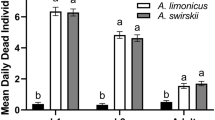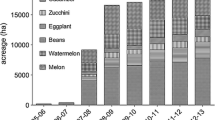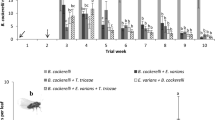Abstract
Potato tubermoth (PTM) Phthorimaea operculella (Lep.: Gelechiidae) is one of the pest species affecting Solanaceae worldwide. It can cause up to 80% of losses in potato open air crops as well as damage up to 100% of tubers during storage. Blattisocius (= Typhlodromus) mali (Acari: Blattisociidae), a predatory mite, was studied as a potential biological control agent of PTM. A prey acceptance bioassay of PTM eggs was carried out. Additionally, two bioassays have been conducted under microcosm conditions, which assessed the densities of mite releases at two levels of PTM infestation. The results showed that B. mali female adults accept PTM eggs as prey, and they cause a mortality rate 89.63 ± 2.47%, 48 h later. In addition to this, under microcosm conditions with potato tubers, we found at low infestation level that the effectiveness of the predatory mite varied from 72.50 ± 28.50 to 100%, 28 days later, according to the release rate of mites. Under high infestation level, the effectiveness of biological control of the pest varied from 53.36 ± 25.55 to 92.51 ± 7.88%, also according to the release rate of the mites. The possible use of biological control with B. mali of PTM, in different types of potato storage, is analysed and discussed.


Similar content being viewed by others
References
Al-Ali AS, Al-Neamy IK, Abbas SA, Abdul-Masih AME (1975) Observations on the biology of the potato tuber moth Phthorimaea operculella zell. (Lep.: Gelechidae) in Iraq. 79:345–351
Alonso-Arce F (2011) Prácticas de cultivo para realizar posteriormente un buen almacenaje de la patata. Vida Rural 335:50–54
Andreadis SS, Poulia Y, Noukari S, Aslanidou B, Savopoulou-Soultani M (2016) Cold hardiness attributes of a field population of the potato tuberworm, Phthorimaeae operculella. Entomol Exp Appl 160:109–116
Arthurs SP, Lacey LA, Roda FR (2008) Evaluation of a granulovirus (PoGV) and Bacillus thuringiensis subsp. kurstaki for control of the potato tuberworm (Lep.: Gelechiidae) in stored tubers. J Econ Entomol 101:1540–1546
Aryal S, Jung C (2015) IPM tactics of potato tuber moth, Phthorimaea operculella (Lep.: Gelechiidae): literature study. Korean J Soil Zool 19:42–51
Athanassious CG, Rumbos CI (2018) Emerging pests in durable stored products. In: Athanassiou CG, Arthur FH (eds) Recent advances in stored product. Springer-Verlag, Berlin, pp 221–227
Baggen LR, Gurr GM (1998) The influence of food on Copidosoma koehleri (Hym.: Encyrtidae), and the use of flowering plants as habitat management tool to enhance biological control of potato moth, Phthorimaea operculella (Lep.: Gelechiidae). Biol Control 11:9–17
Bethke PC (2014) Postharvest storage and physiology. In: Mark P (ed) The potato: botany, production and uses. Navarre R. CABI, Wallingford, pp 255–271
CABI (2018) Phthorimaea operculella (potato tuber moth) http://www.cabi.org/isc/datasheet/40686. Accessed 7 July 2017
Credland P (2010) Stored products research in Europe—a very personal perspective! Julius Kühn Archiv 425:14–25
Darst PH, King EW (1969) Biology of Melichares tarsalis in association with Plodia interpunctella. Ann Entomol Soc Am 62:747–749
Das GP, Raman KV (1994) Alternate hosts of the potato tuber moth, Phthorimaea operculella. Crop Prot 13:83–86
de Moraes GJ, Venancio R, dos Santos VLV, Paschoal D (2015) Potential of Ascidae, Blattisociidae and Melicharidae (Acari: Mesostigmata) as biological control agents of pest organisms. In: Carrillo D, de Moraes GJ, Peña JE (eds) Prospects for biological control of plant feeding mites and other harmful organisms. Springer, Cham, pp 33–75
Dean BB (1994) Managing the potato production system. Food Products Press, Binghamton
Dogramaci M, Tingey WM (2008) Comparison of insecticide resistance in a North American field population and a laboratory colony of potato tuberworm (Lep.: Gelechiidae). J Pest Sci 81:17–22
Douches D, Visser D, Coombs J, Zarka K, Felcher K, Bothma G, Brink J, Koch M, Quemada H (2010) Field and storage evaluations of ‘SpuntaG2’ for resistance to potato tuber moth and agronomic performance. J Am Soc Hortic Sci 135:333–340
Fenemore PG (1977) Oviposition of potato tuber moth, Phthorimaea operculella (Lep.: Gelechiidae); fecundity in relation to mated state, age, and pupal weight. N Z J Zool 4:187–191
Flanders SE, Badgley ME (1963) Prey–predator interactions in self-balanced laboratory populations. Hilgardia 35(8):145–183
Gallego JR, Mellado-López L, Cabello T (2019) Selection of a Trichogramma species (Hym., Trichogrammatidae) for the biological control of the potato moth Phthorimaea operculella (Lep., Gelechiidae) by host-parasitism behavioral study. ITEA-Inf Tec Econ Agr (in print)
Gao Y (2018) Potato tuberworm: impact and methods for control. CAB Rev 13:1–3
Gerson U, Smiley RL, Ochoa R (2003) Mites (Acari) for pest control. Blackwell Science Ltd., Oxford
Hagstrum DW, Klejdysz T, Subramanyam B, Nawrot J (2013) Atlas of stored-product insects and mites. AACC International, Inc, St. Paul
Haines CP (1978) A revision of the genus Blattisocius Keegan (Mesostigmata: Ascidae) with especial reference to B. tarsalis and the description of a new species. Acarologia 20:19–38
Haines CP (1981) Laboratory studies on the role of an egg predator, Blattisoicus tarsalis (Acari: Ascidae), in relation to the natural control of Ephestia cautella (Lep.: Pyralidae) in warehouses. Bull Entomol Res 71:557–574
Hanafi A (1999) Integrated pest management of potato tuber moth in field. Potato Res 42:373–380
Hanafi A (2007) The canon of potato science: 17. Arthropods/insects. Potato Res 50:271–274
Hansen LS (2007a) Biological control of stored-product pests. In: Pimentel D (ed) Encyclopedia of pest management, vol II. CRC Press, Boca Raton, pp 42–44
Hansen LS (2007b) Potential for widespread application of biological control of stored-products pests-the European perspective. J Stored Prod Res 43:312–313
Hansen LS, Nielsen PS, Jespersen JB, Eilenberg J, Enkegaard A, Hansen LM (2001) Biological control of the Mediterranean flour moth (Ephestia kuehniella) in flour mills. DJF Rapport Markbrug 49:105–110
Hassan MF, Ali FS, Hussein AM, Mahgoub MH (2002) Biological studies on Macrocheles muscaedomesticae fed on different stages of potato tuber moth, Phthorimaea operculella. Egypt J Biol Pest Control 12:43–46
Kathage J, Castañera P, Alonso-Prados JL, Gómez-Barbero M, Rodríguez-Cerezo E (2018) The impact of restrictions on neonicotinoid and fipronil on pest management in maize, oilseed rape and sunflower in eight European Union regions. Pest Manag Sci 74:88–99
Keasar T, Sadeh A (2007) The parasitoid Copidosoma koehleri provides limited control of the potato tuber moth, Phthorimaea operculella, in stored potatoes. Biol Control 42:55–60
Khorrami F, Mehrkhou F, Mahmoudian M, Ghosta Y (2018) Pathogenicity of three different entomopathogenic fungi, Metarhizium anisopliae, Nomuraea riley and Paecilomyces tenuipes against the potato tuber moth, Phthorimaea operculella (Lep.: Gelechiidae). Potato Res 61:297–308
Krantz GW, Walter DE (2009) A manual of acarology, 3rd edn. Texas Tech University Press, Lubbock 807 pp
Kroschel J, Koch W (1996) Studies on the use of chemicals, botanicals and Bacillus thuringiensis in the management of the potato tuber moth in potato stores. Crop Prot 15:197–203
Kroschel J, Schaub B (2013) Biology and ecology of potato tuber moths as major pests of potato. In: Giordanengo P, Vincent C, Alyokhin A (eds) Insect pests of potato. Academic, Amsterdam, pp 165–192
Kuhar TP, Kamminga K, Philips C, Walingford A, Wimer A (2013) Chemical control of potato pest. In: Giordanengo P, Vincent C, Alyokhin A (eds) Insect pests of potato. Academic, Amsterdam, pp 375–395
Mandour NS, Sarhan AA, Atwa DH (2012) The integration between Trichogramma evanescens (Hym.: Trichogrammatidae) and selected bioinsecticides for controlling the potato tuber moth Phthorimaea operculella (Lep.: Gelechiidae) of stored potatoes. J Plant Prot Res. https://doi.org/10.2478/v10045-012-0007-6
Narenderan ST, Meyyanathan SN (2019) Sample treatment and determination of pesticide residues in potato matrices: a review. Potato Res 62:47–67
Nesbitt НJ (1951) А taxonomic study of the Phytoseiinae (family Laelaptidae) predaceous upоп Tetranychidae of economic importance. Zool Verh Leiden 12:1–64
Nielsen PS (1998) Blattisocius tarsalis, would this predatory mite be effective against moth eggs in Scandinavian flour mills? IOBC Bull 21:83–87
Nielsen PS (1999a) The use of Blattisocius tarsalis (Acari: Ascidae) for biological control of flour mills. In: Jin Z, et al (eds) Proceedings of the 7th International Working Conference on Stored-Product Protection, Beijing, pp 1265–1268
Nielsen PS (1999b) The impact of temperature on activity and consumption rate of moth eggs by Blattisocius tarsalis (Acari: Ascidae). Exp Appl Acarol 23:149–157
Nielsen PS (2003) Predation by Blattisocius tarsalis (Acari: Ascidae) on eggs of Ephestia kuehniella (Lep.: Pyralidae). J Stored Prod Res 39:395–400
Oerke EC (2006) Crop losses to pests. J Agric Sci 144:31–43
Oudemans AC (1929) Acarologial notes, XCIX, C. Ent Ber 8:28–36
Pascual-Villalobos MJ, Carreres R, Riudavets J, Aguilar M, Bozal JM, Garcia MC, Soler A, Baz A, de Estal P (2006) Plagas del arroz almacenado y sus enemigos naturales en España. Bol San Veg Plagas 32:223–229
Pokharkar DS, Jogi RR (2000) Biological suppression of potato tubermoth, Phthorimaea operculella with exotic parasitoids and microbial agents under field and storage conditions. J Biol Control 14:23–28
Radcliffe EB (1982) Insect pests of potato. Annu Rev Entomol 27:173–204
Rios D (2012) Las papas antiguas de Tenerife. Centro Conservación de la Biodiversidad Agrícola de Tenerife, Tenerife
Riudavets J (2018) Biological control of stored products pests. IOBC WPRS Bull 130:107–109
Riudavets J, Lucas E, Pons MJ (2002a) Insects and mites of stored products in the northeast of Spain. IOBC Bull 25(3):41–44
Riudavets J, Maya M, Monserrat M (2002b) Predation by Blattisocius tarsalis (Acari: Ascidae) on stored product pests. IOBC Bull 25(3):121–126
Robertson JL, Preisler HK (1992) Pesticide bioassays with arthropods. CRC Press, Boca Raton
Rondon SI (2010) The potato tuberworm: a literature review of its biology, ecology, and control. Am J Potato Res 87:149–166
Santos JC, Rueda-Ramirez D, Demite PR, Moraes GJ (2018) Ascidae, Blattisociidae and Melicharidae (Acari: Mesostigmata): zoogeographic analyses on newly available databases. Zootaxa 4377(4):542–564
Saour G (2004) Efficacy assessment of some Trichogramma species (Hym.: Trichogrammatidae) in controlling the potato tuber moth Phthorimaea operculella (Lep.: Gelechiidae). J Pest Sci 77:229–234
Saour G (2009) Effect of early oviposition experience on host acceptance in Trichogramma (Hym.: Trichogrammatidae) and application of F1 sterility and T. principium to suppress the potato tuber moth (Lep.: Gelechiidae). Biocontrol Sci Tech 19:225–234
Schöller M (2004) Potential use of biological control of stored-product pests in bakeries and mills. In: Hansen LS, Wakefield M, Lukas J, Stejskal V (eds) Proceedings WG IV: Biocontrol of arthropod pests in stored products. Research Institute of Crop Production, Prague, pp 31–37
Schöller M (2010) Prospects for biological control of stored-product pests. Julius Kühn Archv 429:25–31
Thomas HQ, Zalom FG, Nicola NL (2011) Laboratory studies of Blattisocius keegani (Acari: Ascidae) reared on eggs of navel orange worm: potential for biological control. Bull Entomol Res 11:1–6
Trivedi TP, Rajagopal D (1992) Distribution, biology, ecology and management of potato tuber moth, Phthorimaea operculella (Lep.: Gelechiidae): a review. Int J Pest Manag 38:279–285
Trivedi TP, Rajagopal D, Tandon PL (1994) Life table for establishment of potato tubermoth Phthorimaea operculella. J Indian Potato Assoc 21:97–105
Urquijo L (1944) Ensayo del parasito útil Trichogramma minutum en la lucha contra la polilla de la patata. Bol Pat Veg Entomol Agri 13:281-300
Vila E, Cabello T (2014) Biosystems engineering applied to greenhouse pest control. In: Torres I, Guevara R (eds) Biosystems engineering: biofactories for food production in the XXI century. Springer, Cham, pp 99–128
White EG, Huffaker CB (1969) Regulatory processes and population cyclicity in laboratory populations of Anagasta kuhniella (Lep.: Phycitidae). I. Competition for food and predation. Res Popul Ecol 11:57–83
Funding
This work has been funded within the project titled: Development of new methods for the integrated management of potato moths Phthorimaea operculella and Tecia solanivora (Ref.: RTA2015-00074-C02-00). It was funded within the programme of main research projects in 2015 and complementary actions within the framework of the state programme R + D + I aimed at society challenges (safety and food quality challenge, sustainable and productive agrarian activity, sustainability of natural resources and sea and marine research). The National Institute for Agricultural and Food Research and Technology (INIA) and Ministry of Economy and Competitiveness, Spain (and European Regional Development Fund, ERDF).
Author information
Authors and Affiliations
Corresponding author
Ethics declarations
Conflict of Interest
The authors declare that they have no conflict of interest.
Additional information
Publisher’s Note
Springer Nature remains neutral with regard to jurisdictional claims in published maps and institutional affiliations.
Rights and permissions
About this article
Cite this article
Gallego, J.R., Gamez, M. & Cabello, T. Potential of the Blattisocius mali Mite (Acari: Blattisociidae) as a Biological Control Agent of Potato Tubermoth (Lepidoptera: Gelechiidae) in Stored Potatoes. Potato Res. 63, 241–251 (2020). https://doi.org/10.1007/s11540-019-09438-9
Received:
Accepted:
Published:
Issue Date:
DOI: https://doi.org/10.1007/s11540-019-09438-9




